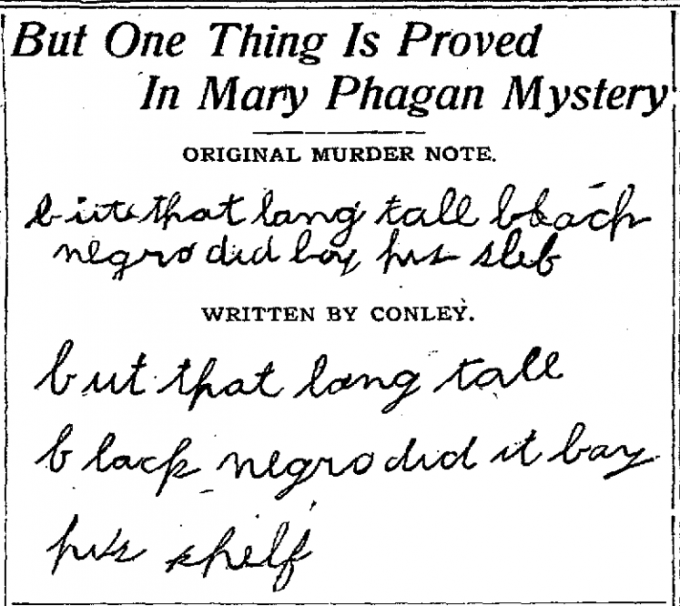Another in our series of new transcriptions of contemporary articles on the Leo Frank case.
Atlanta Constitution
Friday, May 30th, 1913
Amid the warp of falsehood and the woof of conjecture, one thing stands out like a scarlet thread in the Mary Phagan murder mystery—for mystery it still is and still will be until a jury of twelve men fixes the guilt on some man or men.
That one thing—startling in its vivid contrast to the murky maze of contradictions—is the fact that James Conley, the negro sweeper employed at the National Pencil factory, wrote the notes which were found beside the mutilated and lifeless body of Mary Phagan early in the morning of April 26.
Why he wrote them, when he wrote them, whether he wrote at the dictation of someone else or whether he himself committed the crime, are matters yet to be determined. He has lied and lied out of a lie. First he said he wrote the notes on Friday; now he comes forward and admits he wrote them on Saturday, the day the murder was committed. He tells various stories about the writing of the notes. He puts improbable words in the mouth of Leo Frank. He has squirmed and twisted and backed and stalled; but once having stated he wrote the notes his handwriting proves the assertion as indubitiably [sic] as if the bits of paper on which the messages were scrawled bare the crimson imprint of his fingers.
The Big Mystery.
When the Phagan case was in its infancy and the detectives were advancing theory upon theory only cast each aside, the notes found by Mary Phagan’s body proved the big stumbling block in the way of a solution of the mystery. Time and again it would seem that a plausible theory had been framed, only to be shattered when the notes were remembered. Turn which way you would in the intricate ramifications of the known facts and the purely conjectural, the notes would confront the seeker after truth.
Remember the Notes.
“But you must remember the notes,” someone would interpose, and then the search for a new theory would begin all over again.
The idea that Mary Phagan wrote the notes was disposed of at the outset as utterly preposterous, in the very nature of things she could not have done so. There was little doubt that she was dead when her body was hurled into the basement below. An examination of her handwriting later proved that it was totally dissimilar to the characters of the scribbled notes.
Suspicion then turned to Newt Lee. Lee was asked to write the identical words of the notes. His writing bore little resemblance to them, although some amateur experts declared there were similarities.
When James Conley was arrested he stoutly maintained that he could not write at all. Later the detectives discovered that he had bought a watch on the installment plan and that he had signed contracts. They secured these contracts and confronted him with them. He confessed that he had lied. His motive for lying was plain as the noon-day sun. Guilty or innocent, he knew his handwriting would connect him with the crime. Handwriting does not change. Characters in writing may vary, but characteristics do not.
After the discovery that Conley could write, the work of gaining a confession from him was a comparatively easy matter. But to make assurance doubly sure, the detectives, without letting him see the notes found in the cellar of the National Pencil factory, dictated their contents to him and he was told the spoken words. Laboriously he wrote. As character followed character and word followed word, the result was startling. No forger could have produced the same result. The characters were identical.
Take the first word, “but,” of the two notes. Could anything be more perfect than the similarity? And the next word and the next?
The discovery that Conley wrote the notes is the most important thing about the whole case thus far unearthed and made public—it is the only thing established beyond question of reasonable doubt save that little Mary Phagan went to the of[f]ice of the National Pencil factory on Memorial day to draw her pittance of pay and that her dead body was discovered by Newt Lee, the negro night watchman, at 4 o’clock the following morning.
* * *
Atlanta Constitution, May 30th 1913, “But One Thing is Proved in Mary Phagan Mystery,” Leo Frank case newspaper article series (Original PDF)

